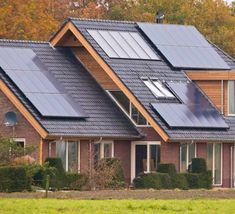Cool roofing is more than just an energy-efficient option; it’s also a green solution that contributes to a greener planet. In this article, we’ll explore how cool roofing helps promote sustainability, reduce environmental impact, and support a more eco-friendly future.
1. Energy savings and reduced carbon footprint
Cool roofing significantly reduces energy consumption for cooling purposes.
By reflecting sunlight and reducing heat absorption, it helps lower the reliance on air conditioning, resulting in reduced energy usage. This leads to a decrease in carbon emissions associated with electricity generation, helping to combat climate change and reduce your carbon footprint.
2. Mitigation of the urban heat island effect
Urban areas with numerous dark surfaces, such as asphalt and concrete, tend to absorb and retain heat, creating what’s known as the urban heat island effect.
Cool roofing plays a vital role in mitigating this effect by reflecting sunlight back into the atmosphere and lowering surface temperatures. By reducing heat buildup in urban areas, cool roofing helps create a more comfortable and sustainable living environment.
3. Reduced air pollution and smog
Traditional roofing materials absorb heat and contribute to the formation of air pollution and smog.
The heat absorbed by dark roofs can react with pollutants in the air, leading to the production of smog and harmful air quality. Cool roofing, with its reflective properties, helps minimize heat absorption and the subsequent chemical reactions, thus reducing air pollution and improving overall air quality.
4. Stormwater management
Cool roofing materials can aid in stormwater management by reducing the amount of rainwater runoff from rooftops.
By absorbing less heat, cool roofs prevent rapid heating and cooling of rainwater, which can lead to increased runoff and strain on stormwater infrastructure. Cool roofs can help reduce the strain on local drainage systems and improve water quality.
5. Use of sustainable materials
Cool roofing materials are often made with sustainable or recycled content.
For example, metal roofing is often made from recycled materials, and cool roof coatings can be formulated using environmentally friendly ingredients. Choosing cool roofing options that incorporate sustainable materials helps conserve natural resources and reduce waste.
6. Longevity and durability
Cool roofing materials are designed to be long-lasting and durable.
By choosing cool roofs that have extended lifespans, you can reduce the frequency of roof replacements and the associated waste generated from old roofing materials. This contributes to the overall sustainability of the built environment.
By opting for cool roofing, you actively contribute to creating a greener planet. The energy savings, reduction in carbon emissions, mitigation of the urban heat island effect, and use of sustainable materials all work together to support environmental sustainability. When selecting cool roofing options, look for products with high solar reflectance, thermal emittance, and environmentally friendly certifications. Consult with roofing professionals who specialize in sustainable roofing to explore the best cool roofing solutions for your specific needs and climate conditions. Together, we can make a positive impact on the environment and create a greener future for generations to come.
If you liked this article, you might also want to check out, The Benefits of Cool Roofing.


